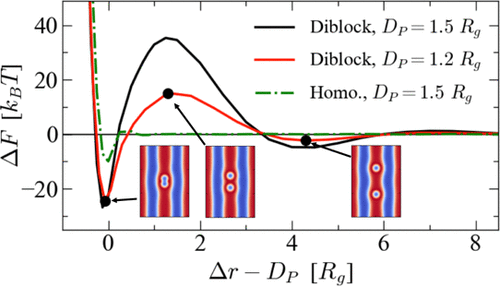Abstract
Block copolymer matrices are often used to control nanoparticle (NP) dispersion behavior, but the effects of diblock domain interfaces on particle–particle interactions have not been well characterized. In this paper, polymer field theoretic simulations are used to quantify interactions between both bare and grafted spherical NPs in microphase-separated A–B diblock copolymers. It is shown that for bare NPs that have an athermal interaction with and a diameter similar to the B domain, the presence of an A–B interface leads to an effective interaction between the particles with multiple minima separated by a free energy barrier. It is further shown that these effects primarily result from chain stretching and compression near the A–B interface induced by particle–particle interactions as opposed to increases in A–B contact at the interfaces. Grafted chains largely prevent these effects and reduce particle–particle interaction strength. When confined by diblock domain interfaces, grafted chains have a reduced extension compared to what is expected for de-wetted brush chains, as commonly described in homopolymer results. Finally, these studies indicate a new route toward linking spherical NPs in a controlled fashion, allowing for tunable plasmonic properties in the case of metallic NPs.
